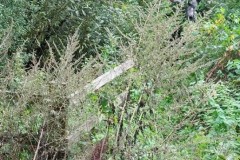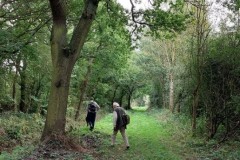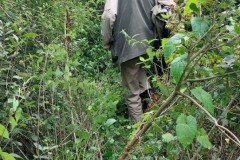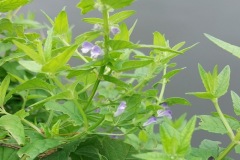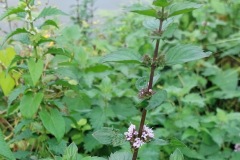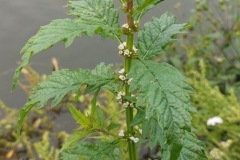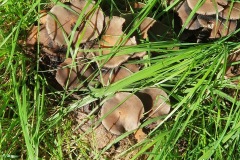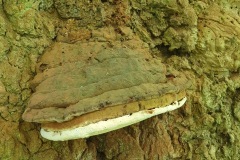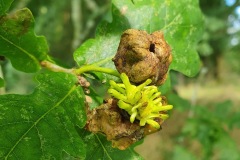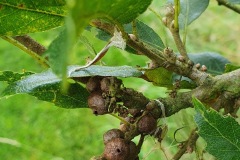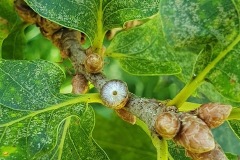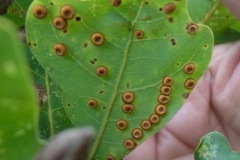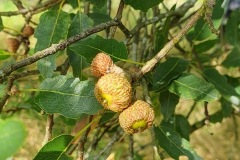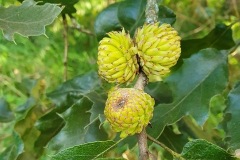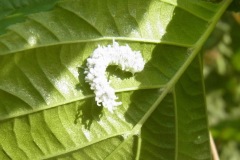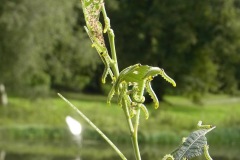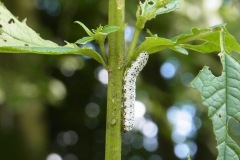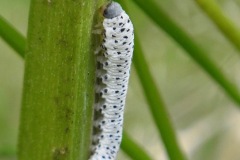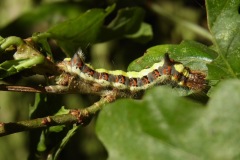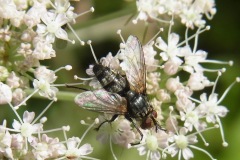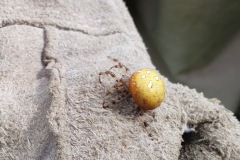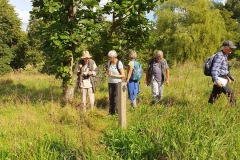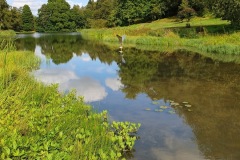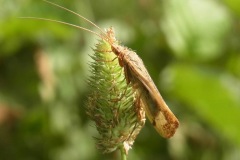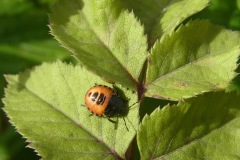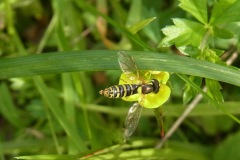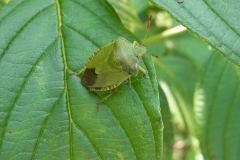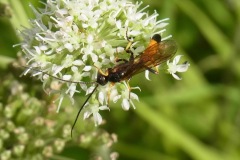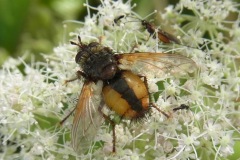Doncaster Naturalists’ Society visit to Sykehouse Lock, New Junction Canal, Fishlake Covert & Pennyshaw Lane, Saturday 16 September 2023
Leader : John Scott.
Members present : CB; CH.
The group met at 10.30 am in the Car Park at Sykehouse Lock on the New Junction Canal (OS Grid Ref. SE639 162. Post code DN14 9AL).
We walked south along the eastern bank of the canal examining the hedgerow, grassy bank and the riparian/aquatic vegetation along the canal path. Due to the absence of a canal crossing at Smallhedge Bridge and the long walk to the next crossing point, the group decided to leave the elevated canal bank via the overgrown wooden staircase to Stony Lane & Smallhedge Lane and return to the car park via Fishlake Covert, Pennyshore Lane and Kirk Lane.
Notes of interest:
1. Considering the absence of any exposed solid geology in this region of heavy clay soils, Stony Lane lived up to its name by revealing a number of water-worn pebbles of carboniferous sandstone. These would have been deposited here from the northwest by glaciofluvial action at the end of the last glaciation.
2. Three aquatic invasive alien species occurred along the canal, Himalayan Balsam, Orange Balsam and Floating Pennywort. The honey-scented Himalayan Balsam, much beloved of Bumble Bees, was a 19th century horticultural import. Though not known in South Yorkshire according to Lees’ Flora of 1888, it now occurs in profusion along water courses throughout the Doncaster district, characteristically in association with Nettles and Hemlock.
The equally glamorous Orange Balsam was first noted in the NJ Canal (its first Doncaster locality) by Louise Hill in September 2008. The Nats two visits to the Canal this year witnessing its spread. The Floating Pennywort, first noticed in the Don in 2010 has only recently colonised the NJ Canal, its presence not mentioned here in the South Yorkshire Plant Atlas (2011). Our visits this year have found it, sometimes in large floating mounds, from the Went Footbridge in the north to Smallhedge Bridge.
3. John drew our attention to subtle east/west ‘ridge and furrow’ undulations in the floor of Fishlake Covert. This indicated the site had been under arable management prior to its establishment as a Hunting Covert. Presumably this land-use change took place after the local (Hatfield, Thorne, Fishlake, Stainforth & Sykehouse) enclosure award was enacted in 1825. The wood is currently managed for game bird (Pheasant) rearing.
| Common Name | Latin Name | SE6316
Canal Bank |
SE6315
Canal Bank |
SE6314
Canal Bank |
SE6314-15
Fishlake Covert |
SE6315
Pennyshore Lane |
Notes |
|---|---|---|---|---|---|---|---|
| Alder, Common | Alnus glutinosa | * | * | * | |||
| Alder, Italian | Alnus cordata | * | |||||
| Amphibious Bistort | Polygonum amphibium | * | * | ||||
| Angelica | Angelica sylvestris | * | * | * | |||
| Annual Meadow-grass | Poa annua | * | * | * | * | * | |
| Arum | Arum maculatum | * | |||||
| Ash | Fraxinus excelsior | * | * | * | * | * | |
| Balsam, Himalayan | Impatiens glandulifera | * | * | ||||
| Balsam, Orange | Impatiens capensis | * | * | * | |||
| Bindweed, Great | Calystegia silvatica | * | |||||
| Bird’s-foot Trefoil | Lotus corniculatus | * | * | * | |||
| Black Bryony | Tamus communis | * | |||||
| Black Medick | Medicago lupulina | * | * | * | |||
| Blackthorn | Prunus spinose | * | * | * | |||
| Bracken | Pteridium aquilinum | * | * | ||||
| Bramble | Rubus fruticosus agg. | * | * | * | * | * | |
| Broad-leaved Dock | Rumex obtusifolius | * | * | * | * | * | |
| Broad-leaved Willowherb | Epilobium montanum | * | |||||
| Burdock, Greater | Arctium lappa | * | |||||
| Buttercup, Creeping | Ranunculus repens | * | * | * | * | * | |
| Chickweed, Common | Stellaria media | * | * | * | |||
| Cleavers | Galium aparine | * | * | ||||
| Clover, Red | Trifolium pratense | * | * | * | |||
| Clover, White | Trifolium repens | * | * | * | |||
| Cock’s-foot Grass | Dactylis glomerata | * | * | * | * | * | |
| Coltsfoot | Tussilago farfara | * | * | * | |||
| Corn Mint | Mentha arvensis | * | |||||
| Couch Grass | Agropyron repens | * | |||||
| Cow Parsley | Anthriscus sylvestris | * | * | * | * | * | |
| Cranesbill, Cut-leaved | Geranium dissectum | * | |||||
| Creeping Cinquefoil | Potentilla reptans | * | * | * | |||
| Creeping Soft-grass | Holcus mollis | * | * | * | * | ||
| Currant, Red | Ribes rubrum agg. | * | |||||
| Daisy | Bellis perennis | * | * | * | |||
| Dandelion | Taraxacum officinale | * | * | * | |||
| Deadnettle, White | Lamium album | * | * | * | * | * | |
| Dog Rose | Rosa canina | * | * | * | * | ||
| Dogwood | Cornus sanguinea | * | |||||
| Dove’s-foot Crane’s-bill | Geranium molle | * | * | * | |||
| Elder | Sambucus nigra | * | * | * | * | * | |
| Enchanter’s Nightshade | Circaea lutetiana | * | |||||
| False Fox-sedge | Carex otrubae | * | * | * | * | ||
| False Oat-grass | Arrhenatherum elatius | * | * | * | * | ||
| Fat Hen | Chenopodium album | ||||||
| Fern, Broad-buckler | Dryopteris dilitata | * | * | ||||
| Fern, Male | Dryopteris felix-mas | * | * | * | * | * | |
| Field Maple | Acer campestre | * | * | ||||
| Fleabane, Common | Pulicaria dysenterica | * | |||||
| Foxglove | Digitalis purpurea | * | |||||
| Giant Fescue | Festuca gigantia | * | * | ||||
| Gipsywort | Lycopus europaeus | * | * | * | |||
| Goat Willow | Salix caprea | * | |||||
| Greater Pond Sedge | Carex riparia | * | |||||
| Greater Stitchwort | Stellaria holostea | * | * | * | * | * | |
| Ground Ivy | Glechoma hederacea | * | |||||
| Groundsel | Senecio vulgaris | * | * | ||||
| Hawthorn | Crataegus monogyna | * | * | * | * | * | |
| Hazel | Corylus avellana | * | * | * | * | * | |
| Heliotrope sp. | Petasites sp. | * | |||||
| Hemlock | Conium maculatum | * | * | * | * | ||
| Herb Bennet | Geum urbanum | * | * | * | * | * | |
| Herb Robert | Geranium robertianum | * | * | * | * | * | |
| Hogweed | Heracleum sphondylium | * | * | * | * | * | |
| Holly | Ilex aquifolium | * | |||||
| Honeysuckle | Lonicera periclymenum | * | * | ||||
| Horse Chestnut | Aesculus hippocastanum | * | * | * | |||
| Ivy | Hedera helix | * | * | * | * | ||
| Knapweed, Common | Centaurea nigra | * | * | * | * | ||
| Knotgrass | Polygonum aviculare | * | * | * | |||
| Lesser Pond-sedge | Carex acutiformis | * | |||||
| Mallow, Musk | Malva moschata | * | * | * | |||
| Maple, Field | Acer campestre | * | |||||
| Maple, Norway | Acer platanoides | * | |||||
| Meadow Vetchling | Lathyrus pratensis | * | * | * | |||
| Meadowsweet | Filipendula ulmaria | * | * | * | * | ||
| Mouse-ear, Common | Cerastium fontanum | * | * | * | |||
| Mugwort | Artemisia vulgaris | * | * | * | |||
| Mustard, Hedge | Sisymbrium officinale | * | * | * | |||
| Nettle | Urtica dioica | * | * | * | |||
| Nightshade, Woody | Solanum dulcamara | * | * | * | |||
| Oak, Pedunculate or Common | Quercus robur | * | * | * | * | * | |
| Oat, Common | Avena sativa | * | |||||
| Osier | Salix viminalis | * | |||||
| Ox-eye Daisy | Leucanthemum vulgare | * | * | * | |||
| Pennywort, Floating | Hydrocotyle ranunculoides | * | * | * | Also SE6416 + 6417 | ||
| Perennial Rye-grass | Lolium perenne | * | * | * | * | ||
| Perennial Sow-thistle | Sonchus arvensis | * | * | * | |||
| Plantain, Rat-tail | Plantago major | * | * | * | * | ||
| Plantain, Ribwort | Plantago lanceolatum | * | * | * | * | ||
| Plum, Wild | Prunus domestica | * | |||||
| Privet, Wild | Ligustrum vulgare | * | |||||
| Ragwort, Common | Senecio jacobaea | * | * | * | |||
| Reed Sweet-grass | Glyceria maxima | * | * | * | * | * | |
| Scentless Mayweed | Matricaria perforata | * | |||||
| Silver Birch | Betula pendula | * | * | ||||
| Skullcap | Scutellaria gallericulata | * | * | * | |||
| Soft Rush | Juncus effusus | * | |||||
| Stinging Nettle | Urtica dioica | * | * | * | * | * | |
| Sycamore | Acer pseudoplatanus | * | |||||
| Tansy | Tanacetum vulgare | * | * | * | * | ||
| Thistle, Creeping | Cirsium arvense | * | * | * | * | ||
| Thistle, Marsh | Cirsium palustre | * | |||||
| Thistle, Spear | Cirsium vulgare | * | * | * | |||
| Three-veined Sandwort | Moeringia trinervia | * | |||||
| Trifid Bur Marigold | Bidens tripartita | * | |||||
| Upright Hedge Parsley | Torilis japonica | * | |||||
| Wall Barley (grass) | Hordeum murinum | ||||||
| Willowherb, Great | Epilobium hirsutum | * | * | * | |||
| Willowherb, Rosebay | Chamerion angustifolium | * | * | * | |||
| Wood Brome | Bromus ramosus | * | |||||
| Wood Millet | Milium effusum | * | |||||
| Woundwort, Hedge | Stachys sylvatica | * | * | * | |||
| Woundwort, Marsh | Stachys palustris | * | * | * | |||
| Yarrow | Achillea millefolium | * | * | * | |||
| Yellow Waterlily | Nuphar lutea | * | * | * | |||
| Yorkshire Fog | Holcus lanatus | * | * | * |
| Common Name | Latin Name | Notes. |
|---|---|---|
| Invertebrates | ||
| Common Darter | Sympetrum striolatum | Hunting insects along ditches and paths around Fishlake Covert. |
| Green-veined White Butterfly | Pieris napi | Fishlake Covert |
| Hornet | Vespa crabro | Active nest in upturned tree root-plate in ditch adjacent to Fishlake Covert. Much ‘toing and froing’ of hornets while we sat on adjacent log having lunch. Most emerging hornets headed off on same compass-bearing (south-west) to forage. |
| Nurseryweb Spider | Pisaura mirabiis | In dry grass adjacent to Fishlake Covert |
| Pond Skaters | Gerris (? lacustris) | Large numbers along all sections of the canal, concentrating within 3m of the bank. |
| Red Admiral Butterfly | Vanessa atalanta | Fishlake Covert |
| Speckled Wood Butterfly | Pararge aegeria | Fishlake Covert |
| Herptiles | ||
| Common Frog | Rana temporaria | Bright yellow/green young specimen by ditch along Pennyshaw Lane. |
| Birds | ||
| Blackbird | Turdus merula | All in or over Fishlake Covert |
| Blue Tit | Cyanistes caeruleus | |
| Buzzard | Buteo buteo | |
| Magpie | Pica pica | |
| Robin (singing) | Erithacus rubecula | |
| Wood Pigeon | Columba palumbus | |
| Mammals | ||
| Mole | Talpa europaea | Fresh hills along canal bank |
| Roe Deer | Capreolus capreolus | Footprints (slots) in clay soil of paths and ditches in and around Fishlake Covert. |
CAH.
Doncaster Naturalists’ Society visit to the Yorkshire Arboretum, Castle Howard, Wednesday 13 September 2023
Leader : Tom Higginbottom.
Members present : IF, TH, TH, NB, CH, SB, JC and SC.
Joint meeting with the British Plant Gall Society at the Yorkshire Arboretum, Castle Howard.
We assembled in the car park and then followed a trail up towards Bracken Hill. The main focus for members of the British Plant Gall Society was to make a complete list of galls found and their hosts. Tom has compiled the list for the BPGS and the Arboretum. This report will mention a few galls but also feature some other species which were photographed by Tricia Haigh and myself and a spider discovered by Colin. To identify the photographer each figure number is followed by either NB for Nora Boyle or TH for Tricia Haigh.
We had only just started looking at oak trees when we came across 3 species of fungi, Fly Agaric, Weeping Widow and Southern Bracket.
See figure 1 (NB) Weeping Widow, figure 2 (NB) Southern bracket
Most of the galls we discovered were on species of Oak of which there were many, so many that when you enter the arboretum you can pick up an Oak Tree Trail to follow.
Of particular interest was an example of both the sexual generation and asexual generation of Andricus grossulariae on Lebanon oak Quercus libania. The asexual generation forms on lateral and terminal buds and has long thin green rectangular spines bright green at first but then going bright red. Seen here with old Knopper galls, figure 3 (NB) .
The sexual generation is rounded with an apical point ,green at first then becoming brown as it hardens. The latter persisting on trees until the autumn. See figure 4 (NB).
Another gall which was new to me which appears in the centre of figure 5 (NB) Is an early stage in the development of Andricus glandulae which is caused by a gall wasp. When mature it is pear shaped and hairy.
Figure 6 (TH) shows Silk button spangle galls Neuroterus numismalis found on an oak tree near to the lake. Interestingly there were only a few examples found.
As mentioned previously a variety of oak species were found, these two with interesting acorns. The first figure 7 (NB) on Quercus x kewensis and the second figure 8 (NB) on Quercus macrolepis Valencia Oak.
As Tricia was walking round the Arboretum she photographed several examples of sawflies. The white fluffy larva in figure 9 (TH) is an early instar stage of the Alder Sawfly Eriocampa ovata on the underside of an Alder Alnus glutinosa leaf. The white powdery layer is supposed to camouflage the larva as a bird dropping! Later instars loose the white powdery camouflage layer and reveal themselves as actual sawfly larvae with a green appearance. Colin Howes discovered these sawflies by the lake devouring a common waterside Sallow Salix sp. of some sort, figure 10 (TH).
Another sawfly found was Tenthredo scrophulariae, the figwort sawfly which are still feeding, primarily on figwort leaves, in September but will soon hibernate in October, figures 11 (TH) and 12 (TH).
Another interesting find was the bright red and yellow larva of the moth Grey Dagger Acronicta psi figure 13 (TH) which will pupate later in the year and overwinter as a pupa.
Tricia photographed many species, some photographs of which can be seen at the end of this report but this one fly Sturmia bella figure 14 is included in this report because of its parasitic lifestyle. The female lays its eggs on nettle leaves, the food plant of several butterflies including Small Tortoiseshell whose caterpillars consume the eggs unwittingly along with the leaves. The fly maggots hatch in the caterpillars’ gut and literally eats them alive.
Colin’s interest in spiders led him to discover this Four-spotted orbweb spider, Araneus quadratus figure 15 (NB) photographed on Colin’s gardening gloves! Notice the banded legs and 4 spots on the body.
Further photos taken by Tricia Haigh on the day.
Doncaster Naturalists’ Society visit to Seckar Wood, Wakefield, Wednesday 6 September 2023
Leader : Tom Higginbottom.
Members present : IF; JB; CH.
Location: SE235 142 between Lawns Dike to the north, Seckar Lane to the south, Intake Lane to the west and the A61 Wakefield-Barnsley Road to the east. The site car Park is off Seckar Lane.
Seckar Wood is a Site of Special Scientific Interest, managed as a Local Nature Reserve by the Wakefield Metropolitan District Council. This undulating site extends over 46.45 ha or 114.78 acres and includes a variety of habitats including ancient woodland, heathland and wetland.
Unlike sites in lowland Doncaster, Seckar Wood is positively alpine at 70m, so the Oaks are mainly Sessile Oak Quercus petraea rather than Quercus robur and the Gorse on the heathland is Western Gorse Ulex gallii rather than Ulex europaeus.
In the springtime the woodland floor is blue with carpets of Bluebells and in late summer (now) the heathland is purple and honey-scented with carpets of Heather.
For further information visit: https://experiencewakefield.co.uk/venue/seckar-wood-nature-reserve/
| Scientific name | Vernacular name |
|---|---|
| AVascular P | |
| Acer pseudoplatanus | Sycamore |
| Alliaria petiolate | Garlic Mustard |
| Angelica sylvestris | Angelica |
| Arctium minus | Lesser Burdock |
| Betula pendula | Silver Birch |
| Calluna vulgaris | Heather |
| Carex pendula | Pendulous Sedge |
| Circaea lutetiana | Enchanters Nightshade |
| Circium vulgare | Spear Thistle |
| Cirsium arvense | Creeping Thistle |
| Corylus avellana | Hazel |
| Dryopteris filix-mas | Male Fern |
| Epilobium angustifolium | Rosebay |
| Filipendula ulmaria | Meadowsweet |
| Holcus mollis | Creeping Soft-grass |
| Hyacinthoides non-scripta | Bluebell (dead inflorescences) |
| Ilex aquifolium | Holly |
| Lonicera periclymenum | Honeysuckle |
| Pteridium aquilinum | Bracken |
| Quercus petraea | Sessile Oak |
| Ranunculus repens | Creeping Buttercup |
| Rubus fruticosus agg. | Bramble |
| Rumx obtusifolius | Broad-leaved Dock |
| Salix x fragilis | Crack Willow |
| Sambucus nigra | Elder |
| Stachys sylvatica | Hedge Woundwort |
| Ulex gallii | Western Gorse |
| Urtica dioica | Stinging Nettle |
| Viburnum opulus | Guelder Rose |
| Invertebrates | |
| Agalis io | Peacock Butterfly (nectaring on sap run) |
| Pararge aegaria | Speckled Wood Butterfly (Many in sun-lit glades) |
| Birds | |
| Buteo buteo | Buzzard |
| Erithacus rubecula | Robin |
| Turdus merula | Blackbird |
| Mammals | |
| Capreolus capreolus | Roe Deer (2 in car park) |
| Oryctolagus cuniculus | Rabbit (droppings) |
| Sciurus carolensis | Grey Squirrel |
| Amphibians | |
| Rana temporaria | Common Frog (froglets near roadside pond). |
CAH.
